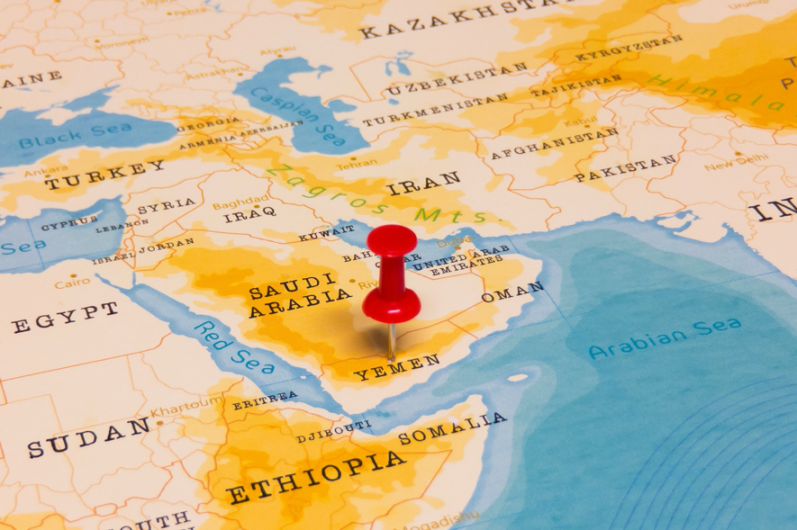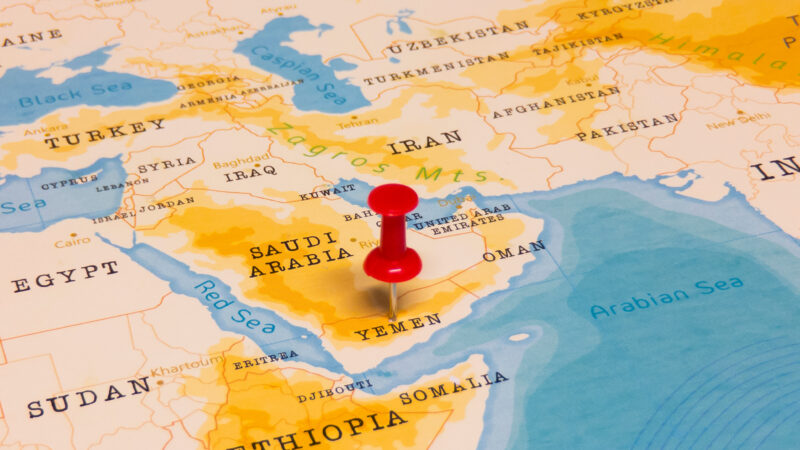Abstract: Humanitarianism may be at death’s door but it still breathing. The crisis in Yemen has shown how aid could be used to provoke the harm of others as well as conceal massacres and drastically violate human rights. The specific situation in Yemen also proved how aid is used as a mechanism of control by states to influence international and humanitarian organizations projects to pursue their own interests. Moreover, strict bureaucratic ties and the lack of coordination and integration with other organizations (local and international) have worsened the situation by complicating aid delivery and the implementation of projects.
Bottom-line-up-front: Humanitarianism has been put at stake in Yemen. However, several scholars and humanitarian workers have explored how it can evolve in order to face the current challenges. Therefore, humanitarianism should take a look at its essence, improve collaboration mechanisms with other regional actors, and pursue an independent status in the global arena. Humanitarianism is in crisis, but crisis can be a means to forge necessary improvements.
Problem statement: Which factors led to the humanitarian crisis in Yemen? How can its implications on the humanitarian system be understood?
So what?: Humanitarian principles have been put at stake. All the aid that is meant to alleviate the suffering provoked by Yemen’s Civil War is being used as another policy tool by some of the warring parties. If humanitarianism wants to survive, all humanitarian agencies should reject all the conditions imposed by their main donors and adhere to the essential principles of humanitarianism.

Source: shutterstock.com/hyotographics
Background and Current Situation in Yemen
The Middle East has widely been considered to be a powder keg for humanitarian and geopolitical interests due to the instability of some countries within the region. One of the most representative examples is Yemen, which since its unification in 1990 has experienced rising levels of violence, resulting in various civil conflicts. In 2014 a civil war broke out between the Hadi’s government and the Houthi minority and lead to the worst ongoing humanitarian crisis in the world.[1] Geographically, Yemen can be classified as the doorstep of the Red Sea, where the Bab al-Mandeb Strait, a relevant geopolitical conduit for around 5% of all world oil trade is the main entrance.[2] It is also worth mentioning that it is located in the Arabian Peninsula and shares borders with a regional superpower, Saudi Arabia, which is highly concerned about how Yemen’s civil war might affect its own stability.[1]
The conflict in Yemen rapidly escalated to a widespread armed dispute between different key actors involving various ethnicities, armed groups, terrorist organizations, and global powers with different motivations and strategies.
These confrontations, however, are not new since due to its colonial and separated past in accordance with its highly divided society (ethnicity and social class), Yemen has suffered from numerous conflicts in its recent history – reflecting the result of a forced brotherhood between all its diverse components.[3]
Moreover, to adequately address the reasons underlying the conflict, its main grassroots must first thoroughly be examined. The causes can be found in recent Yemeni history, particularly in the different clashes that emerged from the uprisings of politically and economically marginalized groups such as the Houthis or the inhabitants in southern Yemen, in response to the systematic exclusion by the Salleh’s government.[1,3] This has been highlighted in their incapacity to peacefully access power, fewer social and political opportunities, and their worsened economic conditions.[3,4] Besides the former colonial heritage, socioeconomic factors, the presence of terrorist groups and a highly corrupted political system, the main reason that propelled the violent outbreak in 2014 could be found in the marginalization – both economically and socially – of social groups, and their systematic exclusion from the Salleh’s political apparatus.[3,4,5] The Salleh government used coercion to control the previously mentioned alienated fractions from rising and overthrowing the system that was the reason for their suffering, thus perpetuating the hegemony of the ruling class through the extinction of any challenging act that emerged from these marginalized and alienated groups[6]. Comparatively, the Arab Spring sparked a new wave of protests that finally ended up in Salleh’s resignation and an increasingly tumultuous spiral of violence that led to a coup d’état executed by the Houthis alongside Salleh’s adepts in 2014.[5]
Besides the former colonial heritage, socioeconomic factors, the presence of terrorist groups and a highly corrupted political system, the main reason that propelled the violent outbreak in 2014 could be found in the marginalization – both economically and socially – of social groups, and their systematic exclusion from the Salleh’s political apparatus.
The Yemeni internal conflict rapidly escalated and called for international intervention once the “elected” president Hadi asked for Saudi Arabian protection and support.[1,5] Many regional and international actors got involved in either the Saudi-led coalition or the conflict itself by supporting different sides and fractions to pursue their individual goals and objectives. The civil war in Yemen is a highly fluid conflict that involves a wide range of actors with different incentives and strategies. As such, internal clashes within previously established alliances are frequently implied.
Despite the multifaceted nature of the conflict, there are six relevant key players whose interests should be taken into account on a deeper level. Four of them are international actors: Saudi Arabia, the United Arab Emirates (UAE), Iran, and the United States (US). The other two are national: the Houthis and al-Qaeda on the Arabian Peninsula (AQAP).
More specifically, Saudi Arabia’s motivations range from securing stability in Yemen to preventing Iran from expanding its influence over the region, thus safeguarding Saudi Arabia’s influence over the Strait. [1,3,5] This is also the case of the UAE, which is principally aiming at thwarting the rise of Islamist political groups in the region as well as exercising influence in various Yemeni port cities and geopolitical hotspots[3]. Further, the US, their main ally, finds its interest in the conflict in combating al-Qaeda and other terrorist and Islamist groups, as well as in countering Iran’s influence in the region.[3,5]
Even though there has been vast and superior support from Saudi Arabia and the UAE against the Houthis, the civil war in Yemen is far from finished. Yemen’s mountainous landscape, evident in other conflicts[7], provides natural shelter and protection for terrorist groups and makes it difficult for the Saudi-led coalition to advance against the Houthis. The latter uses the physical feature to protect themselves and launch attacks against the Saudi-led and Hadi forces[4]. Furthermore, former agreements such as the 2018 Hodeidah ceasefire agreement have been broken down – resuming the confrontations and violence between the warring parties[8]. Overall, the Yemen civil war can be categorized as the worst ongoing humanitarian crisis on a global scale. This is reflected in numbers for instance the 4 million displaced people, the 100,000 killed during the conflict, and the 24 million that are in need of assistance.[9]
Main Humanitarian Players
As previously mentioned, the Yemen civil war consists of a wide number of actors and organizations whose motives and goals frequently overlap in the fields of geopolitics and humanitarianism. This is the case for Saudi Arabia, which in spite of actively participating in the conflict against the Houthis, is the second-largest donor of humanitarian aid to both international entities and their humanitarian organizations including KS Relief or the Saudi Red Crescent Society, which operate under the direct guidelines of the kingdom[10]. Saudi Arabia is followed by the UAE and the European Commission in the third and fourth position respectively[4]. Both Saudi Arabia and the UAE (backed by the US), are actively involved in the conflict, they provide aid to the affected population together with substantial donations to the main bodies in charge of humanitarian activities in Yemen. The United Nations (UN) thus aligns its own interests with humanitarian agendas by making their financial support be considered as an irreplaceable piece when alleviating the suffering since it accounts for more than 67% of all world contributions to this specific issue.[5,10,11] Hence, these actions increase its influence over humanitarian agendas through strict stipulations[10,12], as well as provide good publicity for it and conceal its aid blockade in Hodeida.[4,11] By using these strict terms and forcing aid restriction to certain regions which are not under their control, aid turns into a political tool[13] which aims to both weakening the Houthis and free up more local resources for the Saudi-allied combatants[14]. These actions usually lead to the perception of humanitarian organizations as untrustworthy bodies; thus they are at stake when executing projects and operating which limits their operational scope and increases the odds of being attacked.[4,10]
Besides states’ contributions and operations, there are a wide variety of local and international organizations that perform humanitarian activities to alleviate the consequences of the conflict. Even though the war attracted international attention, most organizations are local and lack adequate resources and materials to effectively addressing the crisis.[10,12] On the other hand, some UN agencies and INGOs operating in the field. Substantial donations from certain actors in conjunction with strict control and influence over aid provision channels have forced their workers to sacrifice their independence in order to maintain access and support when trying to deliver aid to as many people as possible.[4] Furthermore, the relationship between international and local NGOs and humanitarian organizations is far from efficient. Alqatabry and Butcher[12] conducted a survey analysis that showed the different challenges faced by both local and international organizations, which range from donors who constrain NGOs’ actions through challenging conditions in their agreements, difficulties in aid delivery, the imposition of international actors’ view over certain situations, and lack of cooperation and integration between local and international organizations.
Even though the war attracted international attention, most organizations are local and lack adequate resources and materials to effectively addressing the crisis.
Moreover, the UN also faces several challenges: on the one hand, it has been reluctant to condemn Saudi Arabia’s military operations against human rights since it is its major donor in the region[10]. As a result, the damage has been done in terms of how the UN is perceived in conjunction with its principles. Since food security is the primary concern regarding Yemen’s humanitarian crisis, the World Food Programme (WFP) has been distributing food to alleviate this necessity. Nonetheless, the unstable situation and the predominant insecurity all over the country have forced the WFP to build partnerships with different actors, such as the Houthis to meet their objectives. Nonetheless, these collaborations are not always transparent enough, and most of the aid provided is sold on the black market and used to feed members of the armed groups instead of the population.[4] This lack of transparency in aid provision and partnerships has led to an alleged increase in corruption by UN personnel in the field – complicating aid provision and the efficiency of the implemented programs.
In sum, humanitarianism faces several challenges in Yemen that can be summarized as follows:
- an alarmingly increasing influence of states’ interests over their donations and humanitarian purposes;
- the politicization of aid;
- lack of resources among local organizations;
- inefficient collaboration;
- poor integration between local and international organizations;
- untrustworthy perception of humanitarian organizations by the Yemenis;
- the reluctance of large companies in condemning certain actions during the conflict;
- lack of transparency in partnerships;
- increasing corruption in the field.
Entombing Humanitarianism
What Yemen’s humanitarian intervention represents is nothing but the return to a realist approach in international relations. This is embodied by the increasing weight of states such as Saudi Arabia, which by acting as a power maximizer, has not hesitated in using force to augment its influence over the region under the guise of border protection[3]. This holds with the realist assumption that “all states continuously search for opportunities to gain power at the expense of other states”[15]. This fact challenges the main humanitarian principles set in liberal and humanitarian organizations since it endangers their independence and subordinates them to the interests and aspirations of donor states.[16,17] In like manner, it leads to the politicization of aid and their actions together with worsening their perception by aid recipients[10]. This challenge was already addressed by Walker and Maxwell[13] and Rieff[11], who stated that due to the involvement of states as actors and major donors in humanitarian crises, there are few agencies today that are able to refuse contracts and agreements from these donors or the UN. In that way, their traditional humanitarian principles are corrupted and lead to an immediate politicization of aid.
Humanitarian action has found several impediments in the bureaucratic procedures established by the main organizations and difficulties inadequately responding to specific needs.[10,12] Local organizations have demonstrated that they lack sufficient resources to effectively comprehend these specific necessities to properly address them. Moreover, their limited integration and collaboration with INGOs due to fixed guidelines have reduced their scope and potential positive impact on the population[12]. Integrating local staff in humanitarian projects is an essential part of peace-building that must be considered since it has been proven to improve the stability of the country while encouraging the population to value international operations by being involved[16]. Including the local staff would be a precious asset to address specific needs in the region along with improving trust levels within the organizations.[12]
Local organizations have demonstrated that they lack sufficient resources to effectively comprehend these specific necessities to properly address them. Moreover, their limited integration and collaboration with INGOs due to fixed guidelines have reduced their scope and potential positive impact on the population.
Last but not least, the increasing number of humanitarian organizations worldwide need better coordination.[13] Yemen has embodied this main problem in the statements of several humanitarian organizations operating in the field when asserting that there is an imposition of international donors’ desires which do not address the gaps in the society alongside a lack of integration and collaboration between local and international organizations.[12] Thus, a better-coordinated network between both organization types would be necessary to address the issue as well as the formulation of international humanitarian standards to boost common comprehension and actuation between the increasing number and variety of humanitarian organizations.[13]
Conclusion
Despite being at death’s door, humanitarianism is still breathing. Yemen’s crisis has shown how aid could be used to provoke the harm of others in conjunction with concealing massacres and human rights violations. The specific situation in Yemen also proved that aid is a control mechanism by states seeking to influence international and humanitarian organizations projects in order to pursue their own interests. Moreover, strict bureaucratic ties and a lack of coordination and integration with other organizations – local and international – have only worsened the situation by complicating aid delivery and project implementation. What can be concluded after having examined this dramatic scenario is that humanitarianism has been put at stake. However, several scholars and humanitarian workers have inspected how humanitarianism should evolve in order to face these current challenges. Humanitarianism should take a look at its essence, improve collaboration mechanisms with other regional actors, and pursue an independent status in the global arena. Humanitarianism is in crisis, but crisis can forge necessary improvements.
The specific situation in Yemen also proved that aid is a control mechanism by states seeking to influence international and humanitarian organizations projects in order to pursue their own interests.
Iván Escobar Fernández. Humanitarian Action & Conflict postgraduate and International Studies graduate. Editor-in-Chief at the Global Vision Magazine. Collaborator at the Defence Horizon Journal. Former editor at PRISMA UC3M journal. The views contained in this article are the author’s alone and do not represent the views of The Defence Horizon Journal.
[1] Abdullah Al Dosari and Mary George, “Yemen War: An Overview of the Armed Conflict and Role of Belligerents,” Journal of Politics and Law, no. 13 (2020): 53–65.
[2] Peter Salisbury, “Yemen and the Saudi-Iranian “Cold War”” (Research Paper No. 208223, Chatham House, 2015).
[3] Atif Karakir, “Ongoing Conflict in Yemen: A Proxy War?,” Tesam Akademi Dergisi, no. 5: 121–149.
[4] Ben Lowings, Mohammed Sami and Elisa Cherry, “Yemen in 2019: Causes, Crisis and Consequences” (Research Paper, Brussels International Center, Brussels, 2019).
[5] Jeremy M. Sharp, “Yemen: Civil War and Regional Intervention” (Research Paper No. R43960, Congressional Research Service, Washington, United States, 2019).
[6] Stephen Hobden, and Richard W. Jones, “Marxist theories of international relations,” In The Globalization of World Politics: An Introduction to International Relations, 141-154, Oxford: Oxford University Press, 2016.
[7] Paivi Lujala, “The spoils of nature: Armed civil conflict and rebel access to natural resources,” Journal of Peace Research, no. 47 (2010): 15–28.
[8] “UN calls for ceasefire as clashes resume in Hodeidah Port,” Online document, Al Jazeera, last accessed October 22, 2020, https://www.aljazeera.com/news/2020/10/8/yemen-un-calls-for-ceasefire-as-clashes-resumed-in-hodeidah-port.
[9] “War in Yemen,” Online document, CFR, Global Conflict Tracker, last accessed October 22, 2020, https://www.cfr.org/global-conflict-tracker/conflict/war-yemen.
[10] Giulio Coppi, “The Humanitarian Crisis in Yemen: Beyond the Man-Made Disaster” (Research Paper, International Peace Institute, New York, United States, 2018).
[11] David Rieff, “Humanitarianism in Crisis,” Foreign Affairs, no. 81 (2002): 111–121.
[12] Hameed Alqatabry and Charity Butcher, “Humanitarian Aid in Yemen: Collaboration or Co-Optation?,” Journal of Peacebuilding & Development, no. 15 (2020): 250–255.
[13] Peter Walker and Daniel Maxwell, Shaping the Humanitarian World (London & New York: Routledge, 2009).
[14] Jon B. Alterman, „Aid and Conflict: Pitfalls in Yemen” (Brief, CSIS, 2018).
[15] Tim Dunne and Brian C. Schmidt, „Realism,” In The Globalization of World Politics: An Introduction to International Relations, 99-110, Oxford: Oxford University Press, 2016.
[16] Theodora-Ismene and Kristin E. Kosek, “Why Humanitarian Interventions Succeed or Fail: The Role of Local Participation. Cooperation and Conflict,” Journal of the Nordic International Studies Association, no. 40 (2005): 363–383.
[17] Thomas G. Weiss, “Would the World Be Better Without the UN?,” Journal of International Affairs, no. 70 (2020): 29–38.






